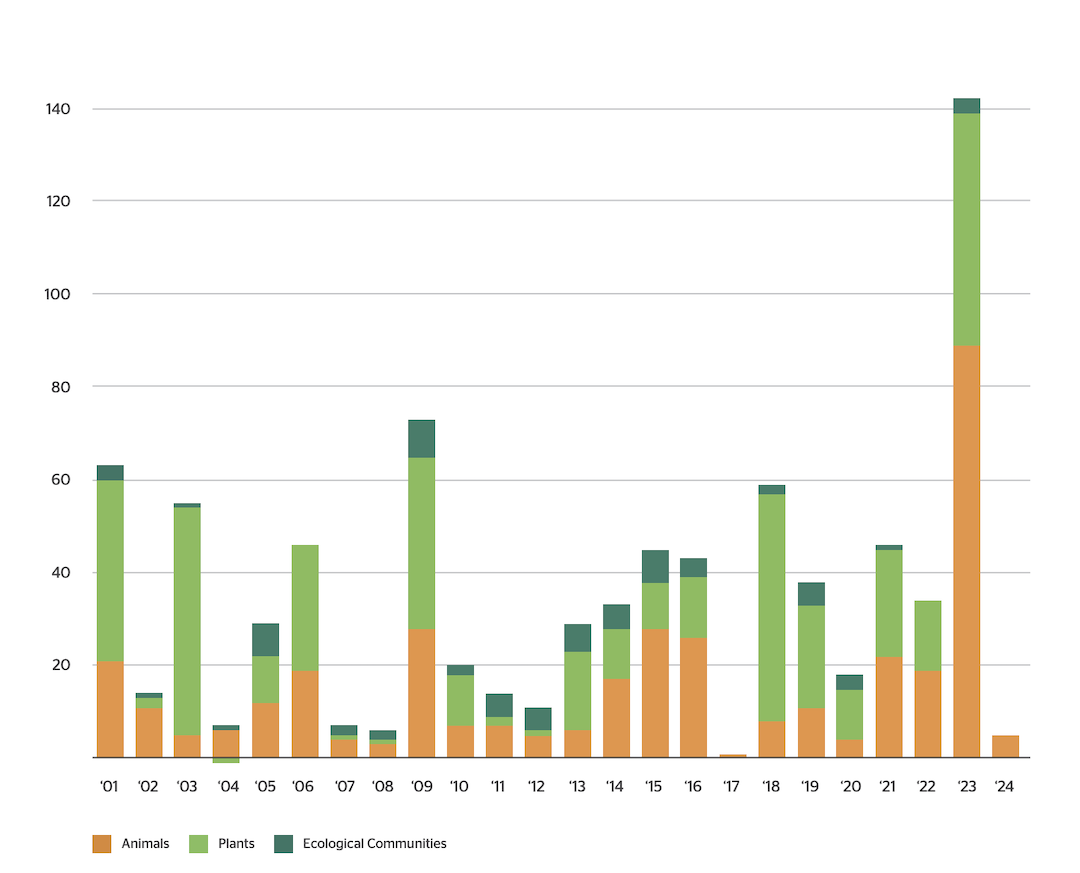Research shows that a record number of Australian species have been added to the national threatened species list over the last two years.
An increase in land clearing and climate change is having a major impact on native animals in a trend which could see higher levels of extinction if not addressed in the immediate future. Major organisations are calling on government bodies to implement new legislation for the protection of flora and fauna before it’s too late.
Australia’s endangered animals
According to research from the Australian Conservation Foundation, 144 species and ecological communities were added to the threatened species list in 2023, bringing the total number of plants, animals and ecosystems at risk of extinction to 2,212.
Additionally, 44 new projects resulted in 10,426 hectares of habitat destruction, equivalent to the size of the Melbourne Cricket Ground 5,000 times over.

Australian Conservation Foundation data on threatened species and ecosystems © ACF. Created with Datawrapper
In a report released by Conservation Volunteers Australia (CVA), it was found that there has been a 50 per cent increase in the number of ‘critically endangered’ Australian animals in the last two years. This is partly due to cuts in conservation law reforms central to the Nature Positive Plan. The current nature laws, which include the NPP and the Environment Protection and Biodiversity Conservation Act, stopped only one project from being approved. This was a thermal coal project in central Queensland.
According to CVA Executive Manager of Policy and Government Relations, Stephen McDonald, “the environment sector has lost tens of millions of dollars and tens of thousands of conservation volunteers critical to saving native species the past two years.
“That’s why we’re advocating a nationally consistent framework for community action and citizen science that can deliver the impact and measurements at scale needed to reverse the decline in our native species.”
Habitat clearing
The Australian Conservation Foundation puts this species endangerment down to the flaws within Australia’s national environmental laws. While the rate of habitat destruction has slowed, making up less than half of the national average over the last ten years, land clearing continues to occur without a proper assessment required under national environmental laws.
With only one project denied approval, this means many native animals face losing massive amounts of habitat. In fact, habitat destruction is the leading cause of plant extinction in Australia, the most common form being for agricultural use such as beef production.

The Invasive Species Council reveals that more than 10 million hectares of land has been cleared since the year 2000. This has created an ‘extinction debt’ as the time lag between habitat destruction and species decline means we are still seeing the impacts of land clearing from years prior.
The impacts of climate change
Another major factor contributing to species endangerment and extinction is the threat of climate change. Fluctuations in the environment have devastating consequences on wildlife health by disrupting ecosystem balance.
Similarly, Wildlife Health Australia reveals that climate change can act as a “threat multiplier,” compounding the influence of other factors such as habitat loss, pollution, tourism and trade to further damage native flora and fauna.
Severe weather events including floods and fires, brought about by changing weather conditions, can directly injure wildlife, displace whole species, contaminate or destroy food and water, and increase species susceptibility to disease outbreaks.
Equally, higher levels of CO2 in the atmosphere lower nutrient levels in plants. This means herbivorous animals are digesting less protein, iron and zinc in their diets. The decline in prey species also impacts the diet of predators, disrupting the entire food chain.

A positive future?
Australia’s endangered species may be at risk due to a number of environmental factors, but there is hope for a stronger future if action is taken now.
Mr McDonald claims that “our experience in bringing animals back from the brink of extinction shows there is hope. But the sheer size of Australia – and the problem – means we need more community action, not less.”
He hopes that organisations and governments will band together to reform environmental protection services and educate communities about the importance of sustainability for the future of native species.
The Australian Conservation Society is also positive about the chance of renewal and regeneration.
“We have the solutions to create a better Australia, for people and nature,” it states in the report.
“Together we can protect the nature and wildlife that still flourish in our big backyard, and work together to restore the places and ecosystems that have been damaged.”
To read about how palaeoconservation is helping to save Australia’s endangered species, click here.

